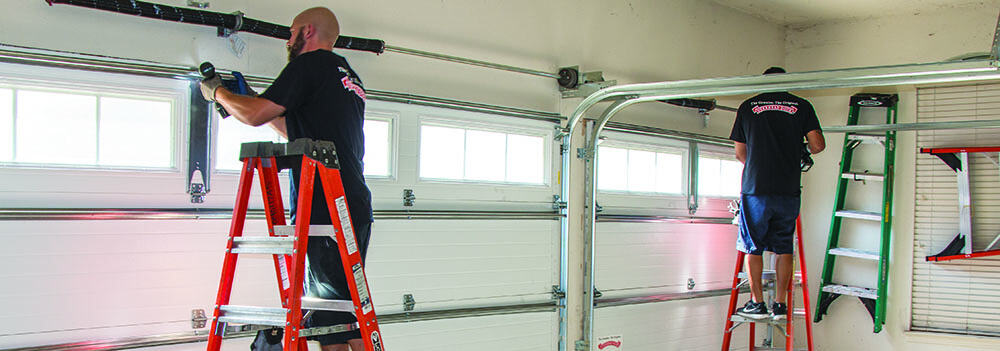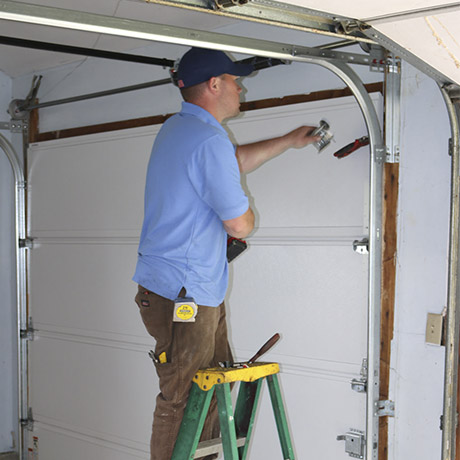Premium Garage Door Service to Prolong Your Door’s Longevity
Premium Garage Door Service to Prolong Your Door’s Longevity
Blog Article
Typical Garage Door Issues and Just How to Repair Them
Garage doors are vital for both safety and security and convenience, yet they commonly offer a selection of common problems that can frustrate home owners. Problems such as excessive sound during operation, doors that stop working to open or shut, misaligned tracks, and malfunctioning remotes can emerge without warning. While some concerns might show up simple to settle, others may need a much more nuanced understanding of garage door auto mechanics. Resolving these troubles efficiently not just enhances capability however additionally lengthens the life of the door. One may question what actions are essential to deal with these difficulties successfully.
Noisy Garage Door Procedure
A loud garage door operation can be a considerable source of annoyance for homeowners, frequently indicating underlying mechanical problems. Such interruptions might stem from different causes, consisting of damaged rollers, loose hardware, or inadequate lubrication. Identifying the resource of the noise is essential for reliable resolution.
One common reason of too much noise is the presence of corroded or damaged rollers. Gradually, these elements can weaken, leading to grinding or squeaking noises as the door moves. Normal inspection and replacement of these rollers can dramatically decrease sound levels. Additionally, loose screws or screws in the door device can create rattling noises during operation. Tightening these bolts guarantees a more stable and quieter activity.
An additional contributing aspect is inadequate lubrication of the door's moving parts. Using a top notch lube to the tracks, springtimes, and rollers can significantly decrease friction and noise. Homeowners should do this upkeep occasionally to maintain optimum performance.
Finally, the garage door opener might also create sound as a result of its age or mechanical issues. If the sound persists in spite of attending to other factors, speaking with a specialist for a detailed examination and possible repair may be necessary.
Door Will Not Open Up or Shut
Experiencing a garage door that will not open or close can be incredibly discouraging and usually signals a breakdown within the system. Several elements can add to this issue, and determining the root cause is crucial for efficient resolution.

Following, inspect the security sensing units located at the base of the door. These sensors can come to be misaligned or blocked by particles, preventing the door from running properly. Tidy the sensing units with a soft cloth and guarantee they are aligned.
Additionally, the garage door's interior components ought to be examined. Issues such as a busted springtime, damaged rollers, or a damaged opener can restrain activity. If any parts seem harmed, it might be suggested to get in touch with a specialist for repairs.
Misaligned Tracks
(Affordable Excellence)Misaligned tracks can significantly disrupt the smooth procedure of a garage door, bring about functional failures such as irregular motion or full immobilization. This issue commonly develops because of a range of factors, including deterioration, unintentional influences, or inappropriate installment. When the tracks are misaligned, the rollers can stagnate freely, which not only stresses the electric motor but likewise postures safety risks.
To determine imbalance, aesthetically evaluate the tracks for gaps or unequal spacing. If you see any kind of inconsistencies, it is crucial to deal with the problem quickly - garage door service. Begin by loosening up the screws that safeguard the track to the wall surface, enabling changes. Thoroughly tap the track back right into its appropriate setting making use of a rubber club or a similar tool, ensuring it is straight and level.
As soon as the positioning is remedied, retighten the screws to protect the track. For a more irreversible remedy, take into consideration enhancing the tracks look at here with extra brackets. Normal upkeep, including cleansing the tracks and making sure rollers are in good problem, can avoid future misalignments. By addressing misaligned tracks without delay, you can bring back the functionality of your garage door and enhance its long life.
Broken Springs
Amongst the different components of a garage door system, broken springs are just one of the most typical problems that can considerably impede its capability. Garage door springtimes are essential for stabilizing the weight of the door, enabling smooth opening and closing. When a springtime breaks, it can cause a door that is challenging to run or, sometimes, entirely unusable.
There are two main kinds of springtimes: torsion springtimes, which are installed above the door, and extension springtimes, found on either side. Indicators of a broken springtime include a door that won't open up, a noticeable void in the springtime, or a loud noise during operation. Attempting to operate a garage door with a damaged spring can cause additional damage to the door or the opener.
Repairing busted springtimes is not a do it yourself project; it calls for specialized tools and experience because of the high stress included. It is recommended to speak with a professional service technician who can securely change the springs and make certain the door is correctly balanced. Routine upkeep and evaluations can help stop springtime failures and expand the life expectancy of the garage door system.
Push-button Control Issues

If the remote still stops working to run, inspect the garage door opener to make certain that its sensing units are clean and unhampered. Dust, particles, or imbalance may impede the signal transmission in between the remote and the opener.
Interference from other electronic tools can also hinder remote capability. Make sure that nearby gadgets, such as cordless routers or cordless phones, are not creating interruptions. garage door service. If disturbance is presumed, attempt relocating these gadgets even more far from the garage door opener
In some situations, the remote might require to be reprogrammed. Seek advice from the supplier's guidelines to reset the remote and integrate it with the garage door opener. If all else falls short and the remote continues to malfunction, think about speaking with a specialist service technician for an extensive examination and possible replacement of the remote or opener.
Conclusion
(Prompt Service)In recap, common garage door issues can dramatically influence performance and safety. Dealing with loud operation involves lubrication and tightening up equipment, while problems with opening or closing call for evaluation of power resources and sensing units. Misaligned tracks can be remedied through change, although damaged springs require specialist intervention. Remote control malfunctions generally arise from weak batteries or disturbance, which can be fixed via substitute or reprogramming. Positive upkeep and timely repairs can ensure optimum efficiency and long life of garage doors.
Report this page